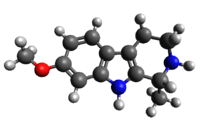Tetrahydroharmine
Tetrahydroharmine (THH) is a fluorescent indole alkaloid that occurs in the tropical liana species Banisteriopsis caapi.[1] THH weakly inhibits serotonin reuptake.[2]
-Tetrahydroharmine_Structural_Formula_V.1.svg.png) | |
 | |
| Names | |
|---|---|
| IUPAC name
(1R)-7-Methoxy-1-methyl-2,3,4,9-tetrahydro-1H-pyrido[3,4-b]indole | |
| Systematic IUPAC name
7-Methoxy-1-methyl-2,3,4,9-tetrahydro-1H-β-carboline | |
| Other names
1,2,3,4-Tetrahydroharmine; Leptaflorine; 2,3,4,9-Tetrahydro-7-methoxy-1-methyl-1H-pyrido(3,4-b)indole | |
| Identifiers | |
3D model (JSmol) |
|
| 3DMet | |
| Abbreviations | THH |
| ChEBI | |
| ChEMBL | |
| ChemSpider | |
| KEGG | |
| MeSH | Tetrahydroharmine |
PubChem CID |
|
| UNII | |
| |
| |
| Properties | |
| C13H16N2O | |
| Molar mass | 216.284 g·mol−1 |
| Basicity (pKb) | 10.334 |
| Pharmacology | |
| Legal status |
|
| Hazards | |
| Flash point | 195.2 °C (383.4 °F; 468.3 K) |
Except where otherwise noted, data are given for materials in their standard state (at 25 °C [77 °F], 100 kPa). | |
| Infobox references | |
THH itself does not inhibit monoamine oxidase. However other harmala alkaloids in B. caapi, namely harmaline and harmine, are reversible inhibitors of monoamine oxidase A. While THH may not play a significant role in the inhibition of MAO it may contribute psychoactivity as a serotonin reuptake inhibitor.[2]
Legal Status
Australia
Harmala alkaloids are considered Schedule 9 prohibited substances under the Poisons Standard (October 2015).[3] A Schedule 9 substance is a substance which may be abused or misused, the manufacture, possession, sale or use of which should be prohibited by law except when required for medical or scientific research, or for analytical, teaching or training purposes with approval of Commonwealth and/or State or Territory Health Authorities.[3]
See also
References
- Callaway, James C. (June 2005). "Various alkaloid profiles in decoctions of Banisteriopsis caapi" (PDF). Journal of Psychoactive Drugs. 37 (2): 151–5. doi:10.1080/02791072.2005.10399796. ISSN 0279-1072. PMID 16149328. Retrieved 2012-08-10.
- Callaway, James C.; McKenna, Dennis; Grob, Charles S.; et al. (June 1999). "Pharmacokinetics of hoasca alkaloids in healthy humans". Journal of Ethnopharmacology. 65 (3): 243–56. doi:10.1016/S0378-8741(98)00168-8. ISSN 0279-1072. PMID 10404423.
- Poisons Standard October 2015 https://www.comlaw.gov.au/Details/F2015L01534
Further reading
- Shulgin, Alexander; Shulgin, Ann (1997). "Tetrahydroharmine". TiHKAL: The Continuation. Retrieved 10 August 2012.